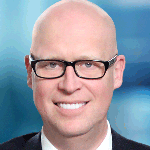
Duane Green
President and CEOFRANKLIN TEMPLETON CANADA

Julian Klymochko
CEO and CIOACCELERATE FINANCIAL TECHNOLOGIES INC.

Dean Orrico
President and CIOMIDDLEFIELD CORPOPRATION

Julian Klymochko, Dean Orrico and Duane Green met with attendees at the 2019 ETF Summit.
Advisors had the opportunity to question, challenge and engage with three C-suite leaders at the 2019 ETF Summit held at the Toronto Region Board of Trade on October 1. Duane Green, president and CEO at Franklin Templeton Canada, Julian Klymochko, CEO and CIO at Accelerate Financial Technologies Inc., and Dean Orrico, president and CIO at Middlefield Group met with attendees in three breakout rooms, a smaller-group format that encouraged a lively interchange of ideas.
Green was asked if Franklin Templeton’s decision to offer ETFs had the potential to cannibalize the firm’s mutual fund sales. So far, he replied, that hasn’t been happening. Rather, Franklin Templeton has met a new cohort of advisors who use ETFs as core portfolio building blocks. However, if there is a bleed away from mutual funds in the future, he added, “I’d rather keep it in house than have it go elsewhere … so it’s a bit of a defensive play on our part to have the different vehicles. And you will start to see us launch more ETFs that replicate a mandate in a mutual fund wrapper.”
First and foremost, Green emphasized, expanding into ETFs has been about “providing choice and options for advisors and investors to build portfolios [by] delivering investment capabilities in a different wrapper.” To that end, he said, there is a need to educate investors about the fact that ETFs are no longer exclusively passive investment vehicles – and that the ETF structure remains very cost-effective, even when you intro- duce active management.
“You have to learn and adapt,” Green said, “and I think that if you’re an investment firm that is sitting there thinking, ‘I don’t want to get into this space because it’s the perceived lower-margin business and I want to stay up here with the juicier stuff,’ you’re going to get left behind.”
Orrico clearly agreed; Middlefield launched a family of ETFs earlier this year. “We’ve consciously taken existing closed-end TSX-listed funds and converted them into ETFs, as opposed to launching an ETF from scratch with maybe 1 or 2 million dollars from a designated broker… That helps alleviate advisors’ concerns around size and liquidity because our ETFs start off with meaningful assets and trading volume,” he said.
Asked to comment on the prospects for a recession, Orrico responded, “Given where we are in the economic cycle, we think it makes even more sense to allocate cap- ital to active managers. We know that passive strategies are fuelling the rapid growth, but we’ve seen good demand in the active ETF space recently. If active managers are doing their jobs properly and continue generating superior risk-adjusted returns compared to passive solutions, they really should be able to justify their inclusion in investor portfolios.”
In the current environment, he continued, “public real estate investment trusts are some of the best income-producing equity investments out there, and it’s a sector you can own for all seasons. [However,] that doesn’t mean you can buy a passive REIT ETF and just put it away and never look at it again, because each sub-sector within real estate behaves very differently. Properly navigating the industrial, office, multi-family or retail real estate segments during various stages of the economic cycle requires an expert manager.”
“Our mission is to democratize alternatives,” stated Klymochko, whose firm launched its first three alternative ETFs this summer. “As more and more investors – whether they be institutions or advisors or even retail investors – begin to apply more of an endowment-style investing allocation, which utilizes alternatives, we want to become the go-to brand.”
Klymochko was asked how his ETFs ensure they maintain sufficient liquidity. “That’s really important when investors are allocating to alternatives,” he said. “Our products are alternative ETFs. They trade in the market every day. So we need to make sure the underlying assets are liquid as well. We are only long and short liquid public securities.” He explained that all three ETFs are managed in-house and are 100% systematic, driven by Accelerate’s multifactor models. One even comes with a 0% management fee and a 20% performance fee, so investors pay nothing for poor performance.
Another question related to the firm’s status as a start-up: how can advisors be confident Accelerate will still be around in 12 to 18 months? Klymochko emphasized that Accelerate is well capitalized. “We invested quite a bit of money and brought on a bunch of investors to back it up, such that we would have sufficient time to execute our business model and have a number of years of running room,” he explained.
There’s no question for Green, Klymochko or Orrico that the future is bright for ETFs, especially as this once passive-only vehicle continues to evolve to fill the needs of a broad range of investors.
INTERACTIVE C-SUITE DISCUSSIONS SPONSORS



